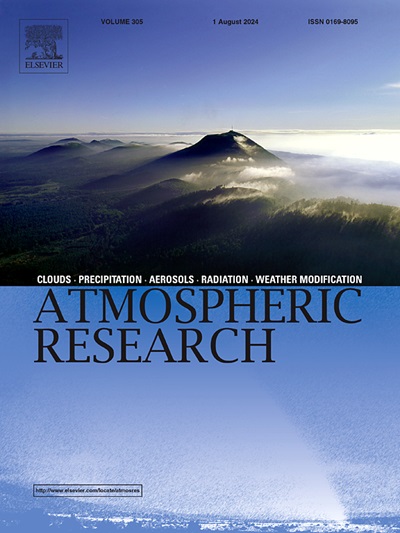Analysis of cloud enhancement events in a 30-year record of global solar irradiance at Thessaloniki, Greece
IF 4.5
2区 地球科学
Q1 METEOROLOGY & ATMOSPHERIC SCIENCES
引用次数: 0
Abstract
In this study, we investigate the characteristics of global horizontal irradiance enhancement events induced by clouds over Thessaloniki for the period 1994–2023 using data recorded every one minute. We identified the cloud enhancement (CE) events by creating an appropriate cloud-free irradiance reference using a radiative transfer model and aerosol optical depth data from a collocated Cimel sun photometer and a Brewer spectrophotometer. We found a trend in CE events of , and a trend in the corresponding irradiation of . To our knowledge, such long-term changes in CE events have not been presented in the past. The peak of the CE events was observed during May and June. CE events with duration longer than 10 min are very rare (), with exceptions lasting over an hour and up to 140 min. Finally, we have detected enhancements above the total solar irradiance at the top of the atmosphere for the same solar zenith angle of up to , with the 75 % of the cases below . Most of these extreme events occur in spring – early summer, with a secondary peak in autumn.
希腊塞萨洛尼基 30 年全球太阳辐照度记录中的云增强事件分析
在本研究中,我们使用每分钟记录一次的数据,研究了 1994-2023 年期间塞萨洛尼基上空由云引起的全球水平辐照度增强事件的特征。我们利用辐射传递模型和气溶胶光学深度数据,确定了无云辐照度参考值,这些数据来自一台共用的 Cimel 太阳光度计和一台 Brewer 分光光度计。我们发现CE事件的趋势为+112±35例/年,相应的辐照度趋势为+329.9±112.0kJ/年。据我们所知,CE事件的这种长期变化过去从未出现过。CE 事件的高峰期出现在 5 月和 6 月。持续时间超过 10 分钟的 CE 事件非常罕见(<8%),例外情况是持续时间超过一小时或达到 140 分钟。最后,在同一太阳天顶角下,我们检测到大气顶部的太阳总辐照度增强,最高可达 204W/m2,其中 75% 的情况低于 40W/m2。这些极端事件大多发生在春季-初夏,秋季是次高峰。
本文章由计算机程序翻译,如有差异,请以英文原文为准。
求助全文
约1分钟内获得全文
求助全文
来源期刊

Atmospheric Research
地学-气象与大气科学
CiteScore
9.40
自引率
10.90%
发文量
460
审稿时长
47 days
期刊介绍:
The journal publishes scientific papers (research papers, review articles, letters and notes) dealing with the part of the atmosphere where meteorological events occur. Attention is given to all processes extending from the earth surface to the tropopause, but special emphasis continues to be devoted to the physics of clouds, mesoscale meteorology and air pollution, i.e. atmospheric aerosols; microphysical processes; cloud dynamics and thermodynamics; numerical simulation, climatology, climate change and weather modification.
 求助内容:
求助内容: 应助结果提醒方式:
应助结果提醒方式:


